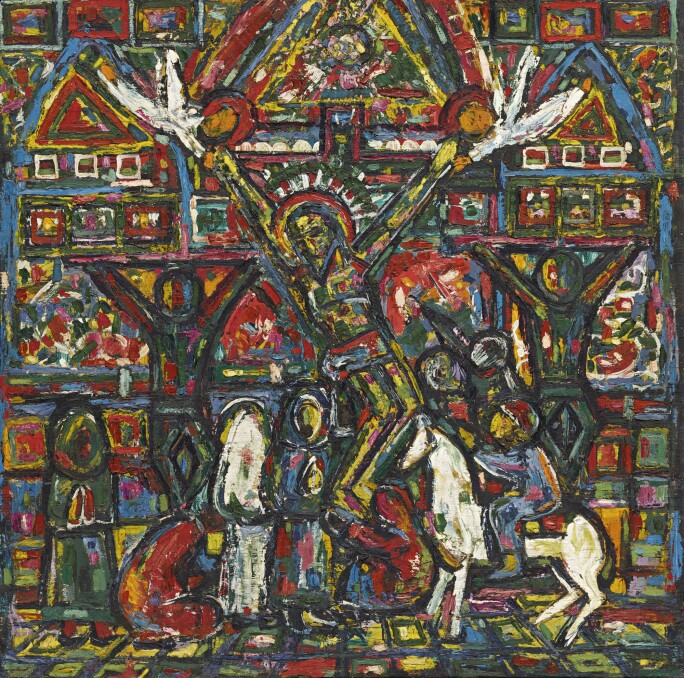A s a child, Francis Newton Souza suffered from a serious attack of smallpox and his Catholic mother vowed that if he ever survived she would enroll her son in the Jesuit priesthood. Although Souza never became a priest, the Roman Catholic Church in Goa gave him his first ideas about images and image making.
His mother’s vow that he would join the priesthood should he be cured seems to have imparted a dark sense of responsibility on a child’s consciousness. A dream world was born: phantasmagoria, hallucinations, angels in paradise, all vividly imagined. Souza’s numerous religious works communicate the artist's fear, anger, fascination and faith in relation to a religion that both fascinated and revolted him, and draw both from the iconography of the global visual lexicon of the Catholic Church as well as in the imagery he saw in the churches of his native Goa as a child.
In Golgotha in Goa, Souza took the imagery from the altar at the Church of the Holy Sepulchre at Golgotha in Jerusalem, (which is believed to be built upon the sight of Jesus's crucifixion) as inspiration. He mirrors the structure and imagery of the icons and sconces. On full display is his deliberate use of powerful impasto, often seen in his early works. These sweeping, boundless, expressionistic brushstrokes add texture and deconstruct his forms to the edge of abstraction. Bright blocks of color pop out from these deep recesses, producing a mosaic-like effect, reminiscent of the soldered cement conjoining glass panes. Similar in style to cloisonnism, Souza evokes the imagery and feel of traditional stained glass, which he would have seen in churches of Goa, still a Portuguese colony at the time, where Catholicism was the dominant religion. This vivid arrangement of forms, both familiar and iconic, are at the heart of Souza’s extensive series of paintings where he explored religious suffering, so central to the imagination of his childhood.
This work was completed in India in 1948, the year after India gained independence from Great Britain as well as the year after Souza founded the Progressive Artists' Group and married Maria Souza. This painting captures the small but crucial period between his total embrace of the modern and departure from the traditional, academic style, where he experimented with Fauvism and Expressionism.
Souza soon emigrated to London where his style evolved dramatically towards Cubism. Throughout his peregrinations, the city of Goa always remained close to Souza’s heart. He retained this painting in his personal collection until shortly before his passing. It was acquired in 1999 by a private collector, a fellow-Goan, who like Souza felt a deep emotional connection to the land of his birth. The painting’s bright, kaleidoscopic palette recall the altars and shrines dotting the Konkani landscape as well the rich texture of Goa’s unique culture, underpinned by deep rooted faith and pride in its Indo-Portuguese heritage. Golgotha in Goa celebrates this tradition and the unchanging values that anchor it.



